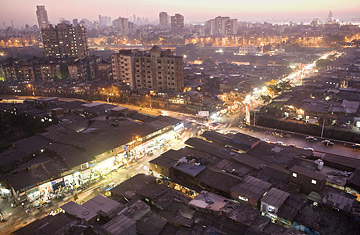
A view of a main intersection in Dharavi slum, with Mumbai city scape in background, in Mumbai, India
(2 of 2)
Mumbai desperately needs one. Take its creaking airport. Founded in fields on the city's edge more than six decades ago, the Chhatrapati Shivaji International Airport is now squeezed by roads, slums, apartment blocks and hotels. With 25 million passengers a year, it is India's busiest airport and one of the 40 busiest in the world. But it is also tiny: just 2,000 acres (800 hectares) of land compared with 25,000 acres (10,000 hectares) in Kuala Lumpur, which serves a similar number of passengers. Over the years, slum encroachment on three sides of the airport has eaten up 276 acres (112 hectares), further hemming in airport operators. In May 2006 the government privatized the airport to encourage its renewal. The new owners, an Indian-South African consortium, have already built a sparkling new domestic terminal. But relocating the 350,000 people essentially squatting on airport land may prove more troublesome. The consortium's lead company, GVK, says it has identified about half the land it needs to fulfill its contract to build new apartments for all the slum dwellers. But finding more land close to the airport may be tough, which is sure to increase local resistance. "We have colleges, schools and everything close by," says Gracy Perereia, 21, a student who lives with her family in a tiny sliver of hutments wedged between a highway and the end of a runway. "Sixty, seventy percent of the people here work at the airport. How will they get there if they put us miles away?"
With better infrastructure. What may finally turn years of talk about a new Mumbai into reality is India's booming economy and what GVK spokesman Manish Kalghatgi calls a political "consensus that as India itself is emerging as a business destination, you should have infrastructure that meets those aspirations." A massive new highway perched on pylons rising from the seafloor will take traffic off Mumbai's overcrowded streets, out across its biggest bays and around some of its many peninsulas and islands, while work on a long-planned subway system may begin soon. Policymakers sometimes argue that the delays caused by the burdens of democracy and bureaucratic dithering may hurt their country in the short term but encourage much healthier and more inclusive long-term growth. There is no better test case for that sentiment than the redevelopment of Dharavi. Get it right, and Mumbai's experience can really be a lesson to the world's other megacities. Get it wrong, and Mumbai will choke on its own poverty and prosperity alike.